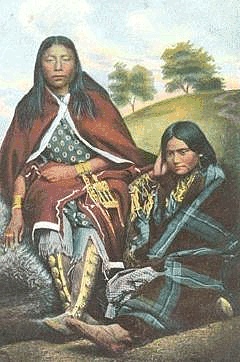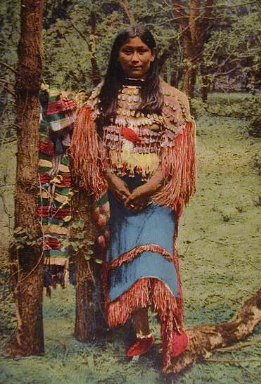The Texas Kiowa Indians
by R. E. Moore
www.TexasIndians.com
 PAYPAL Support
Texas Indians. Even $1.00 helps. It costs to keep things going. So help.
PayPal or a credit card in PayPal. It's safe and YOU really help. You can
afford one soda? Then send the same amount and support us. It really helps.
PAYPAL Support
Texas Indians. Even $1.00 helps. It costs to keep things going. So help.
PayPal or a credit card in PayPal. It's safe and YOU really help. You can
afford one soda? Then send the same amount and support us. It really helps.
 Kiowa man and his wife.
Kiowa man and his wife.
The Kiowa lived in and
around the Texas panhandle. This includes western Oklahoma and northeast
New Mexico. They were nomadic buffalo hunters. That makes them hunter gatherers.
They were famous for their long distance raids. Some of these raids went
all the way down into Mexico and way up almost to Canada. They were friends
and close allies with the Comanche who lived in the same region.
Click here for a
map showing
where the Kiowa lived
Like the Comanche, they
lived in tee-pees. Tee-pees are easy to move and being nomads the Kiowa
moved all the time. They moved to follow buffalo herds. Buffalo meat was
their most important food. www.TexasIndians.com They also gathered plants,
roots and berries to eat when they could find them. The women did this
gathering. The men hunted.
They organized themselves
by age. This is called age grade social organization. This means people
of certain age ranges would belong to social organizations. As a person
got older he or she would move from one social organization to the next.
The boys and young men's organizations were the most important.

Here is a nice example
of Kiowa dress. This lady is wearing an elk tooth blouse. The elk teeth
are the white things in rows. They are sewn onto the blouse. The blouse
is probably made of elk skin.
Elk teeth and skin was
believed to be powerful love magic. A woman wearing elk skin and teeth
was irresistible to men.
The Kiowa speak a language
called Tanoan or Kiowa-Tanoan. Tanoan is a large family of several related
languages. Kiowa is a form of Tanoan. This is important because there are
other Tanoan speakers, the Pueblo Indians. Not all of the Pueblo Indians
speak Tanoan. But, most of the Rio Grande river valley Pueblos speak a
form of Tanoan. Tiwa is one branch of the Tanoan language. Towa and Tewa
are two other closely related Tanoan languages.
Language is an important
way to trace ancestry because whole tribes do not drop one language and
start speaking another. By looking at the relationship between cultures
who speak related languages you can begin to see how societies are related
and where they come from.
Most of the Tanoan speakers
live in south New Mexico along the Rio Grande river. The Tigua in El Paso
Texas are another Tanoan speaking tribe. They speak a form of Tanoan called
Tiwa. In fact, the word Tigua in Spanish is pronounced Tiwa. Also, you
can add or remove the "o" and compare Kiowa with Tiwa or Tiowa
or Kiwa with Tiwa. The "T" and the "K" are pronounced
very much the same way.
The other Texas tribe
that probably spoke Tiwa or a form of Tanoan are the Jumano. In fact, Dr.
Nancy Hickerson, author of "The Jumano", UT press, speculates
that the Kiowa may be descendants of the Plains Jumano.
Another Tiwa speaking
Pueblo tribe is still close to the old Kiowa land. The Taos Indians live
in the Taos Pueblo in northern New Mexico. You can find this on a map.
Just look in north eastern New Mexico for the city of Taos. The pueblo
is right next to the town. It is still there and the Taos Indians still
live there.
It is a little know
fact that the land the Kiowa claim in the Texas Panhandle used to have
Pueblo villages. There are a number of Pueblo ruins along and near the
Canadian River. These ruins were abandoned around 1350-1400
There are other Tiwa
speaking Pueblo tribes. The Isleta Pueblos speak Tiwa and live near modern
Albuquerque. In Spanish times a whole region just south of modern Albuquerque
with many Tiwa Pueblos was called Tiguex.
The Pueblo Indians live
in big buildings called, ready now, pueblos. A pueblo is like a big apartment
house with lots of rooms. Pueblos are made of big mud bricks. They look
pretty cool and you should get a picture of one to look at. They grow corn,
beans and squash. Taos Pueblo is famous for trading with the plains Indian
tribes for buffalo hides and meat. They traded corn for these things. Now
that you know about the Kiowa’s relatives, lets look at the Kiowa.
It is not clear just
where the Kiowa came from. Kiowa tradition says they came from the north
up near Montana. The fact that they speak Tanoan suggests they came from
New Mexico. It is possible that they are a group of Puebloan Indians who
migrated north long ago and then migrated back. The Pueblo have old stories
that say that they migrated in all four cardinal directions -- north, south,
east and west. This was long ago. The stories say that after they had migrated
east, west, south and north they returned to New Mexico and Arizona. They
say where they live now in New Mexico and Arizona is the center of the
earth, the best place to be.
Some of these stories
tell about monkeys and parrots that could only be found far to the south.
Other stories tell about ice and deep snow, like what is found in the far
north. The Kiowa also have stories of going south till they saw monkeys
and parrots and of the far north and snow and ice. The Kiowa stories match
up nicely with the Puebloan stories.
One Kiowa story tells
about a place far up north, Bear Butte. That's the Indian name. The white
man name is Devil's Tower. I like the name Bear Butte better. A butte is
like a small mountain with a flat top. Bear Butte is in Montana near the
South Dakota border. It is near the Black Hills in South Dakota. The Black
Hills a very holy place for several Plains Indian tribes. The Lakota were
the last tribe to live there, but the Kiowa, Cheyenne and several other
tribes consider Bear Butte and the Black Hills a sacred place. Here are
some pictures of Bear Butte. These pictures was taken at a ceremony on
the old Sun Dance grounds next to the butte. These pictures were taken
with the permission of the ceremony leaders because they wanted people
to see that it took place. The fact that the Kiowa consider Bear Butte
one of their sacred places shows they have been there and not just on a
short visit.